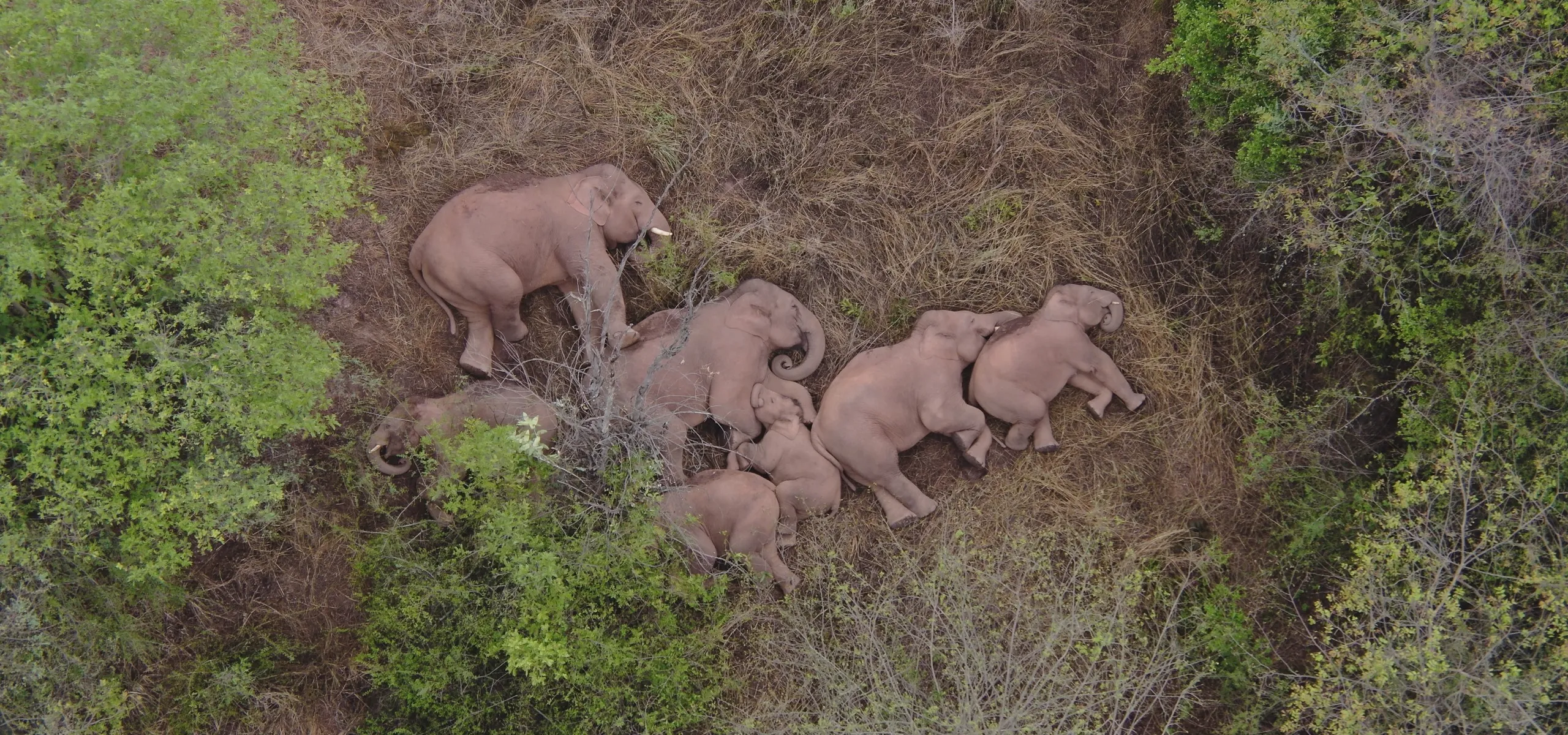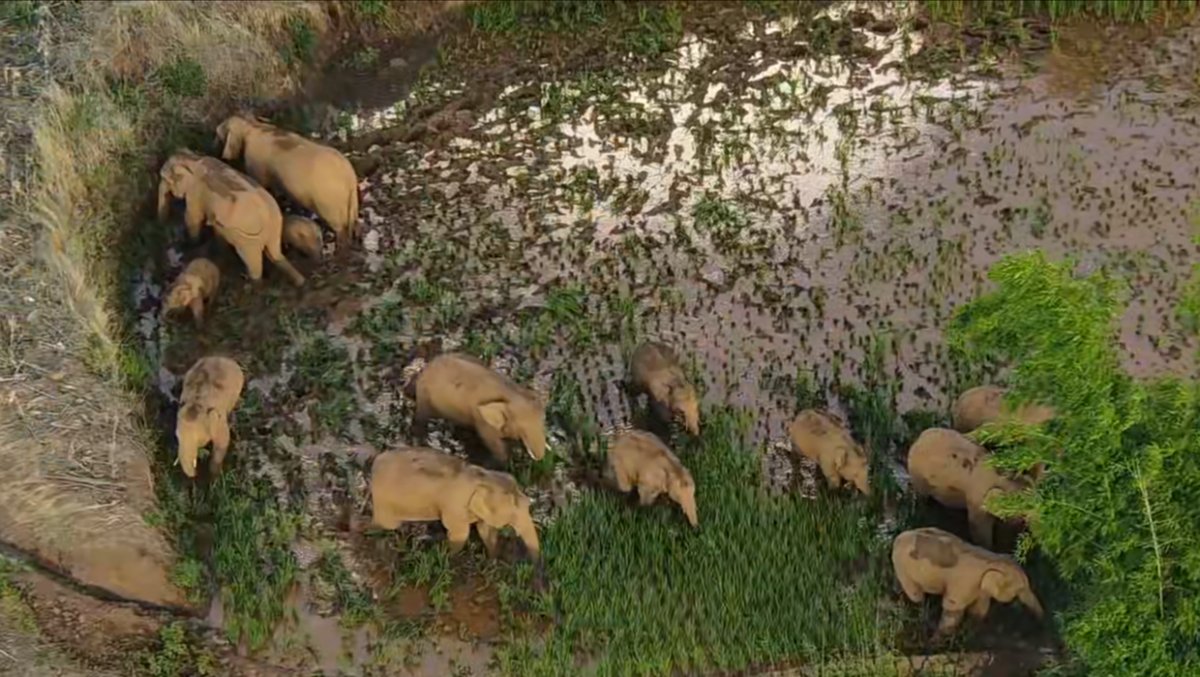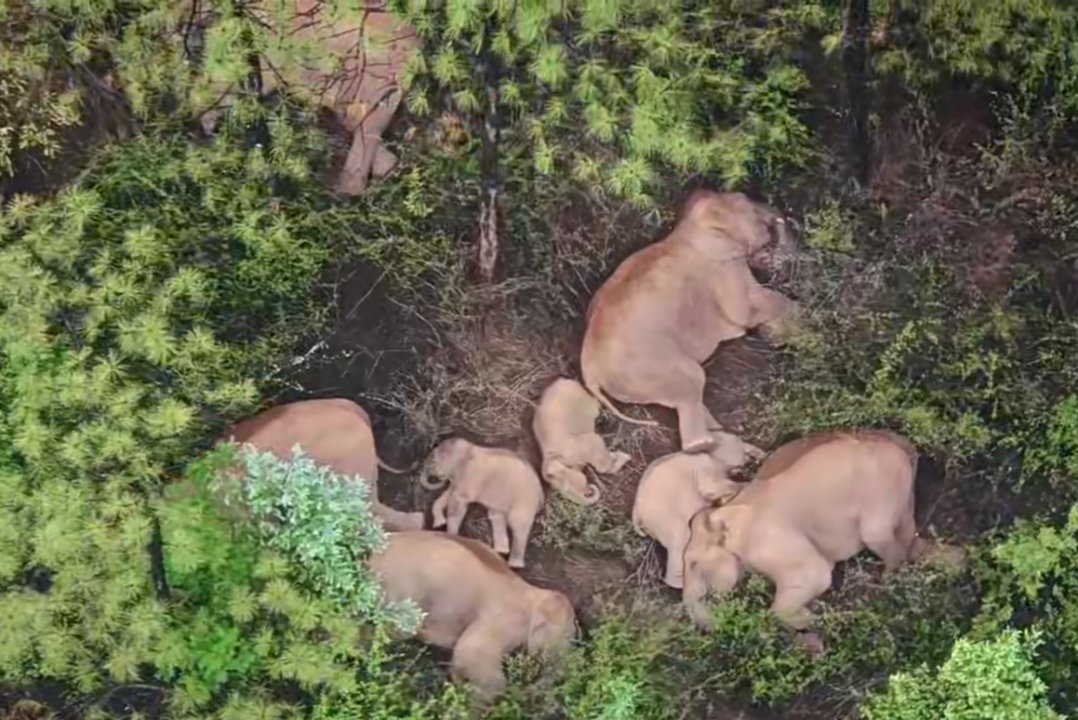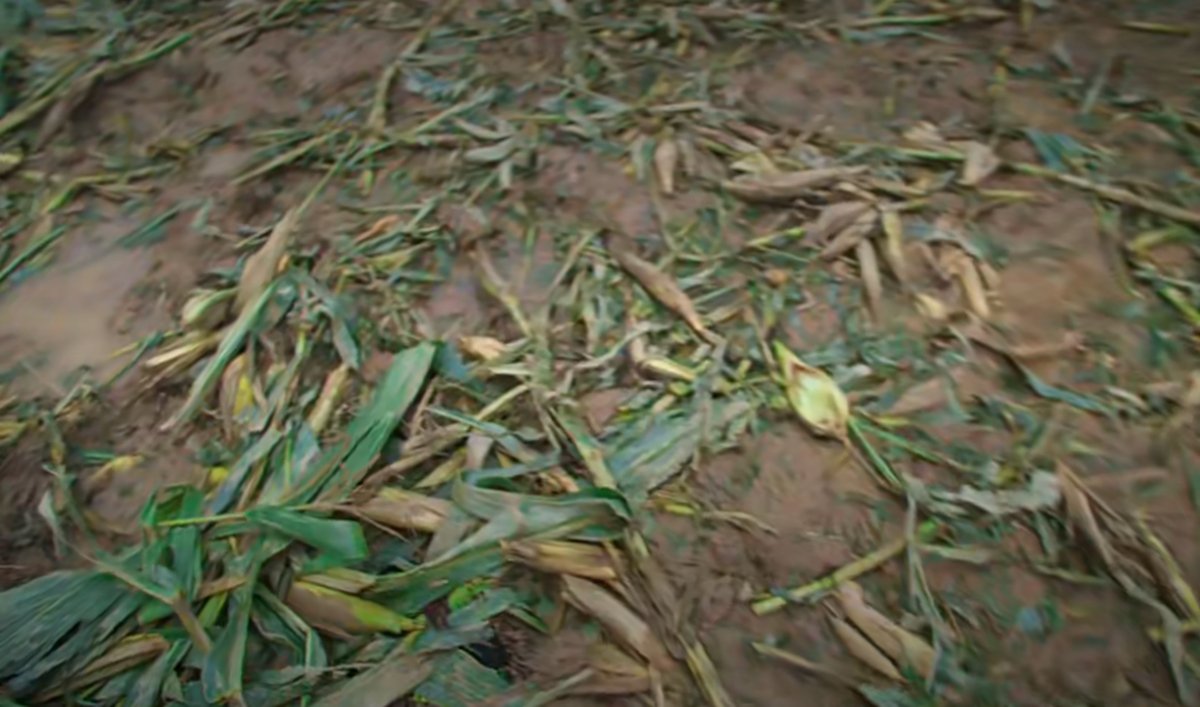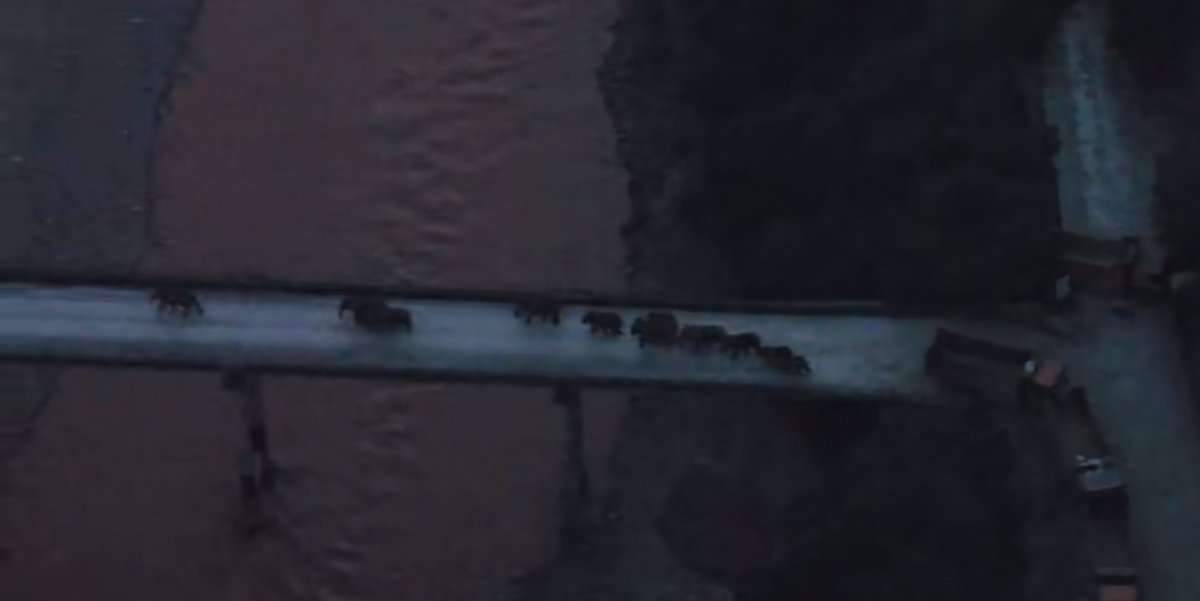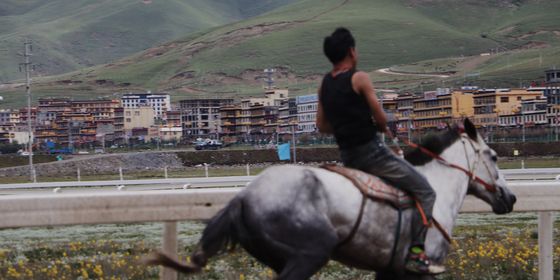Director Olivia Chen talks about filming an elephant herd on a march through Yunnan province
August 12, World Elephant Day, has come and gone. On this day, you might have remembered that a year ago, a herd of rogue elephants seized the headlines with their journey to the north. While such a trumpeting parade did attract plenty of attention worldwide, we still don’t seem to understand much about the actual subject of the news—the Asian elephant.
Film director Chen Yizhi (Olivia Chen) is about to change that. Chen has placed wildlife front and center in various works throughout her 10-year career in documentary filmmaking. As of recently, she has tracked the unusual pilgrimage of these colossal creatures up north and back home to the south in the documentary March of the Elephants, co-produced by China Review Studio and Tencent SSV (Sustainable Social Value Division). For this episode of Story FM, we get to talk with Chen about her experience.
When it comes to wildlife documentaries, the average Chinese viewer is sure to recall Zhao Zhongxiang and his voice-over work on the CCTV nature show Animal World, bringing to national TV screens the lions and leopards of the African savannah. However, China itself has vast and rich wildlife populations across its varied geographic landscapes. From deserts to grasslands, basins, tropical rainforests and wetlands, what kind of wild creatures live alongside humankind in this country?
Guided by this curiosity and in her capacity as a film director, Chen set out to seek her own answer to this question from behind her camera lens. Features in her portfolio include red-crowned cranes, finless porpoises, Chinese alligators, wild pangolins, and the skywalker hoolock gibbons, just to name a few species. Her documentary A Love Song to the Skyline has won a series of well-known international awards and nominations such as Best Film at the International Wildlife Film Festival (IWFF).
Subsequently, Chen travelled to Yunnan, where she met the Asian elephants in the summer of 2021. This is what happened.
-1-
Hide-and-Seek
My name is Chen Yizhi, and I am a director of wildlife documentaries. My first close encounter with Asian elephants took place at a nature reserve in Xishuangbanna Dai Autonomous Prefecture, where I was initially covering an assignment involving insects. At the time, there were two additional wild family herds migrating back home to the southwest after a fairly mysterious journey. I happened to meet one of these herds, composed of 15 elephants that I got to see for the first time through the footage taken by a local person’s drone.
Huge as they are, the elephants on the drone monitor resembled a herd of pigs. They could be seen tentatively surrounding man-made shacks for a round of exploration with their trunks, as if taking part in a treasure hunt—drinking water from buckets, hooking items from under some iron shed and more. All of a sudden, I felt like I had entered a playful paradise where humans and elephants played a joint game of hide-and-seek.
-2-
Breaking Point
As I would come to find out, these pachyderms had indeed caught the attention of people in China and even overseas.
Asian elephants have always been an endangered species in China. However, they have never received quite as much attention as giant pandas have. There are a little over 300 wild Asian elephants living with relative stability between Xishuangbanna and Pu’er.
That is, until recently: In 2020, a herd of these elephants courageously set out on a journey from Pu’er to Honghe, all the way north. Initially, they made sure to stay away from areas densely populated with humans. They kept their distance until the second leg of their exodus, where strips of farmland, villages, and cities replaced the dense forests. The elephants’ northward migration inevitably posed safety hazards to local residents along the road. This, in turn, caught the public’s attention.
However, the increased attention only brought even more chaos to the elephants’ unlikely trek. A swarm of bloggers took to the scene, eager to join the action, waving their smartphones at close range instead of keeping the recommended safe distance from the subjects of their interest.
In order to ensure the elephants’ safety, the relevant government departments denied many a media outlet permission to cover the event. I’d been hoping to shoot some footage myself, but my plans were now thwarted.
August came around and I met two producers of the documentary March of the Elephants. Seeking to spotlight the elephants’ migration, China Review Studio had joined forces with Tencent’s brand new Sustainable Social Value Division. Together, they were planning on co-producing this documentary, hoping to delve into the biodiversity and ecological issues that have long been a source of concern for the future of these lumbering mammals. I took my chance to jump aboard this project, thinking that it aligned with my own ideas of sustainable conservation. Once I obtained my filming permit and located the appropriate funds, I embarked on my journey documenting the antics of these wild Asian elephants.
-3-
Unforgettable Memories
I was warned by local staff upon arrival that some reporters had stayed where I now was for 10 days and even half a month without ever getting to see the elephants with their own eyes.
The following day, I followed the monitoring team’s car up the mountain. Under normal circumstances, we would have kept a safe distance from the elephants. This was typically about one or two kilometers, roughly one mountaintop away.
It was a foggy day, and our surveillance drones lost track of the elephants. However, they had left traces betraying their presence nearby. Everyone was nervous that the elephants would burst into the village suddenly. Thus, we were forced to abandon the usual safety protocol to try and find them as soon as possible.
Eventually, an elephant appeared less than 50 meters in front of our vehicle. This was my first up close encounter with them.
I will never forget that scene.
The two youngest elephants in the family herd appeared in front of our car, accompanied by their guardians—possibly their mother and aunt. While we fretted about a possible collision, the first elephant turned away from us. The two female elephants proceeded to flank their babies before taking a sharp U-turn and making a detour around our car.
These elephants were as large as they were tolerant, and willing to get along with us humans in order to avoid any and all danger for their young.
It is relatively difficult to ascertain the survival rate of a baby elephant before the age of 4, when they are usually weaned by their mothers. Many of them simply do not make it. Those who do survive will usually grow to reach quite a size, so this early stage is critical for their growth.
It’s hard for me to describe my emotions as these events kept unfolding. A blend of fear, awe, and surprise washed over me all at once. Here we were, facing these huge animals for whom we insignificant humans were no match—but their protective instincts toward their babies prevailed.
Somehow, I could sense the subtle strength of their maternal affection. Perhaps it was because I am a woman myself.
-4-
Habits
A family herd usually consists of a dozen elephants. If we are to describe their social organization based on human concepts, elephants belong to matriarchal clans where the eldest female leads the rest of the herd to safe habitats, setting their itinerary and ensuring their collective survival during their migrations.
Before setting out together for a new destination, the herd will send two or three young adult male elephants as a scouting party of sorts, in order to check the route ahead—overall safety, road conditions, and the like. Once they’re back, the matriarch decides whether the rest of the herd proceeds, or stays put and continues looking for food where they are.
On that note, mealtimes are no simple affairs for these enormous creatures. An adult elephant may spend up to 16 hours a day eating, and sleep the rest of the time.
Elephants are also very smart. When they’re in their natural habitat in Pu’er, Yunnan, they will keep track of when corn and rice crops will ripen in the farmlands around them. At the right time, they will pay a visit to the fields, and their timing is rarely off by more than three days.
Furthermore, elephants won’t eat just anything. They will only gobble crops that have ripened to maturity, and leave the rest for future feasts.
The long-rooted farming practices in the region have pushed these elephants to gradually adapt their habits in order to strike a certain harmony with the villagers’ schedule. At night, when we sleep, the elephants take to the fields to eat. In the daytime, when the villagers busy themselves on their farms, the elephants hide in the woods and rest.
If the crops are in abundance, the elephants typically entrench themselves in the cornfields atop the mountain and will not come down for about a week. If they find themselves short on food, they can quicken their pace and cover dozens of kilometers in a single night. This is quite the test of the physical fitness of baby elephants.
To ensure the safety of the youngest members of the herd, older elephants must take care of them along the way. Young adult elephants and their older peers will stand guard around sleeping calves. Sometimes, the mother and aunt will sandwich a baby between them, blocking its hind legs to prevent it from waking up and running around at night.
Elephants have enjoyed a degree of fame on Weibo. The most popular video featuring them on this social media platform shows one such family herd lying down to sleep, stretching and falling on one side like a pile of dominoes. This is, in fact, a rare phenomenon and a sure sign that the herd feels relatively safe.
-5-
Bidding Farewell
Before setting out on my recording journey, all the reports I’d read on these wild elephants focused on the unbearable cuteness of the baby elephants. Now that I was, in fact, getting to witness everything first-hand, I found that the elephants’ clan antics were without a doubt the one aspect that differed the most from my expectations.
There’s something else to be said about elephants, both small and large—they’re extremely sensitive creatures. Their emotions are delicate, and they communicate with each other incessantly. Baby elephants will behave much like hyperactive human children, playfully pushing one another when they’re nibbling leaves and bark during mealtimes. Adult elephants reach and gently pat one another with their trunks to read their neighbors’ emotions. If its neighbor is not in a good mood, an elephant might place its trunk on its neighbor’s back, or they might playfully hook their trunks together.
Elephants come equipped with a patch of sensory cells in the main nasal chamber at the end of their trunks, near their mouths. This patch is a vomeronasal organ, otherwise known as the Jacobson organ. By detecting all pheromones in the outside world, the Jacobson organ acts like a central processing unit and will help the elephants assess each other’s emotions.
However, no matter how much they love one another, members of any elephant herd are bound to bid farewell to each other every now and then.
For instance, male elephants stay with the herd until they reach adulthood. However, when that moment comes, they must leave their family in order to find suitable mates in other herds, thus passing on their genes.
Male elephants often display a violent temperament, especially during breeding season. They are known for wreaking havoc on farmlands along their way—destroying water pipes, smashing water buckets, and even, in the case of one runaway specimen, knocking down an entire coconut tree.
Though this may strike us as a seemingly destructive spree, a closer look into an elephant’s world and emotional state will reveal a much simpler fact—these young male elephants are, in fact, lonely teenagers roaming around in a frantic, solitary pursuit of love. Faced with this challenge for their future and survival, in the absence of a partner, there are only so many ways for them to vent.
-6-
A Mixed Bag of Reactions
Though elephant sightings are a common occurrence in these regions, their presence is far from always foreboding destruction. In fact, Asian elephants in China have always lived around human villages. Additionally, in the course of my filming process I also found out that locals in different areas react in different ways to the elephants’ appearance.
For example, the north-bound family herd elicited mostly excitement from locals in places such as Honghe, Yuxi, and Mojiang. Feeling that this was an event “unlikely to reoccur in the next three centuries,” the villagers didn’t resent the elephants for partaking of their crops. In fact, they even fed them their favorite treats—plantains and hearts of palm.
However, farmers in Pu’er—the elephants’ frequent stomping grounds—are of a different opinion. The regular arrival of these mammoth intruders is nothing but a nuisance to them.
After all, these villagers have spared no efforts to grow their crops all year—all for the elephants to devour in a single sitting. They’re entitled to compensation from the government and insurance companies for lost crops, but who wouldn’t feel bad to see their fields destroyed? Therefore, farmers have had to adapt their crops accordingly. Nowadays, locals have gradually replaced their corn and rice plantations with dragon fruit, which the elephants aren’t particularly fond of.
But the elephants’ crop-eating habits are not just a matter of economic loss to the farmers—risks to personal safety are also a major concern.
At some point during our film crew’s time with the elephants, we knew for a fact that the herd was already approaching the village. We had hoped that they would spare the village on their way up to the mountains, but the abundant local rice paddies were too enticing a temptation. People stood no chance against them—they could only brace themselves for the inevitable. Attempting to scare the colossal marauders away might very well trigger an aggressive response.
In preparation for the elephants’ arrival, a local team will activate a joint protocol of sorts as soon as they spot the herd at the edge of a village. Every household is to turn their lights off and evacuate to higher ground. Such measures are meant to minimize all potential stimuli to the elephants’ curiosity, which may in turn prompt them to head toward the villagers’ homes to explore. As long as they’re left to dine in peace, the herd will make its exit after two or three hours.
-7-
Crossing the Yuan River
It would seem apparent that wild elephants exert a significant impact on the lives of humans who live alongside them. If that’s indeed the case, why not hold them back as soon as they started heading north?
In fact, such was the recommendation of many an expert on Asian elephants at the time. However, with the elephants’ best interests in mind, the government eventually opted to escort them and then guide them back to their original habitats. This approach aimed at understanding the temperament of this family herd, helping them to let down their guard and realize that they were safe. Once we familiarized ourselves with the herd and gained their trust, we could start guiding them back south.
Thanks to these efforts, the herd of Asian elephants made a relatively smooth march to the Yuanjiang River, a crucial milestone for their return south. Crossing the river meant that the herd had entered the boundaries of Pu’er, where they can live in a suitable habitat, away from human settlements. Experts started working out the route across the river well in advance of the herd’s arrival.
Though adult elephants are usually adept swimmers, the timing of their trip during the rainy season and the presence of two calves in the herd added an element of significant danger to the crossing—the currents were surely too fast for the youngest members of the family. Faced with the real concern that the elephants would try to force their way across the perilous river anyway, the experts planned to guide them to a shallower reach for them to cross.
Everyone came prepared with contingency plans, including anticipating that the elephants might refuse to cross or cooperate. Eventually, they decided to guide the elephants across a bridge. To this end, they dug small reservoirs and scattered gifts of corn for them to eat and drink along the way.
This was, in fact, a pioneering feat in history. There are no records of elephants ever crossing a bridge. After all, they are partial to the more familiar environments of dirt roads or river basins.
In order to effectively guide the elephants across the bridge to safety, we blocked all alternative paths with trucks. Once the herd determined the river was too deep for them to cross safely, they would realize there was only one way left. The elephants acknowledged the situation on their own slow, gradual terms, and eventually chose to cross the bridge.
-8-
Equality and Symbiosis
Our experience assisting the family herd across the Yuanjiang River marked the climax of this eventful, tacit cooperation between humankind and elephants. Though by no means an easy feat, our collective effort brought the elephants to safety without any conflict between wildlife and humans along the way.
The filming of our documentary had also come to an end. However, our concerns about elephants and the biodiversity issues that had prompted their migration were far from over.
When it came to the elephants’ plight, the general public had only paid attention to the juiciest headlines. We had borne witness to a much more intricate story. We’d journeyed along with these wild mammals, gaining a deep, intimate understanding of their antics, emotions, survival strategies, and qualities. We could only be in awe of the elephants.
We could no longer believe in our own superiority over animals—though they are certainly different from humankind, we all inhabit the same Earth.
As a wildlife photographer, I often snap images that reflect realities unknown to or overlooked by the public eye. However, this time the brave herd of Asian elephants had recklessly broken into our narrow field of vision. They were a living, breathing fable, reminding humankind to safeguard our planet’s biodiversity.
The next time I went to Xishuangbanna, I watched two videos shot by villagers on their mobile phones. One of them starred a rather burly Asian elephant forcing its way into a narrow alleyway while the villagers ran away—all but one elderly woman. Faced with the elephant, this grandma quietly walked over, knelt down, and kowtowed repeatedly to her sudden visitor, who was now standing still. In the second clip, an elephant managed to march into a farmer’s courtyard. A local threw a steel bucket straight at the elephant’s face. The animal didn’t even blink. It just stood there quietly, letting the humans kick up a fuss.
We live in an ever-developing society that is starting to be increasingly aware of ecological and environmental issues. Armed with our enhanced awareness, can we possibly step out of our usual, self-absorbed path in order to stop and reflect on our role in this world, on our planet Earth—even in the universe we all inhabit?
Images from Chen Yizhi (Olivia Chen)
***
March of the Elephants was released on August 12, and has been broadcast on domestic and foreign mainstream media and new media platforms such as Tencent Video, Mango TV, iQiyi, Bilibili, British Sky TV, and CCTV.





